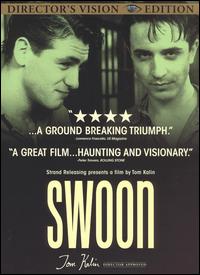Written for MUBI Notebook on May 11, 2020. — J.R.
“Stranger Than Paradise” in One Shot

“We can bet that this film will be a flop,” blurbed Jean Eustache about his fellow post-New-Wave underachiever and pal Luc Moullet’s Anatomy of a Relationship (1975), an early exercise in self-scrutiny coauthored by Moullet’s partner Antoinetta Pizzorno. “That’s the best for me: I’ll plunder it more easily.” In comparable fashion, a 1964 commercial flop made by one of the masters of both Eustache and Moullet, Jean-Luc Godard — who incidentally had helped to launch the careers of both of these disciples — was successfully plundered by Jim Jarmusch twenty years later in Stranger Than Paradise. More specifically, Jarmusch appropriated a black-on-white principle exploited by Godard mostly in interiors to depict a deadbeat trio of two male lowlifes secretly smitten by a foreign female while planning their inept capers in drab surroundings — Claude Brasseur, Sami Frey, and Anna Karina (a Dane in France) in Band of Outsiders; John Lurie, Richard Edson, and Eszter Balint (a Hungarian in the U.S.) in Stranger Than Paradise. The white void seen here by Jarmusch’s trio in a suburban Ohio snowscape, subsequently replicated by a white void in a suburban Florida seascape, is mostly physical — unlike the metaphysical void faced by Godard’s trio in a Paris suburb, who have only movie clichés to fill their plans and imaginations.
Read more
Possibly from the October 26, 1995 issue of Chicago Reader. I’m only guessing, because the Reader itself dates this review a decade earlier, about seven years before the film was made. — J.R.

Tom Kalin’s 1992 first feature is a postmodern retelling of the Leopold and Loeb story, playing up the suppressed gay subtext (at their murder trial in 1924 and then in prison) and playing down more familiar aspects of the case, such as Clarence Darrow’s role. Strikingly shot in black and white by Ellen Kuras and generally well acted, the film is a bit pedantic and mechanical in its revisionism and not always persuasive in its treatment of the period, yet it still carries some interest—if you can accept its polemical stance of treating the men’s crime as a secondary issue. With Daniel Schlachet, Craig Chester, Ron Vawter, Michael Kirby, Michael Stumm, and Paul Schmidt.
 Read more
Read more
This appeared in the June 11, 1993 issue of the Chicago Reader; I’ve also appended an irate response from a reader that appeared in a subsequent issue, along with my response. –J.R.

CLIFFHANGER
** (Worth seeing)
Directed by Renny Harlin
Written by Michael France and Sylvester Stallone
With Sylvester Stallone, John Lithgow, Michael Rooker, Janine Turner, Rex Linn, Caroline Goodall, Leon, Paul Winfield, and Ralph Waite.
Kitsch is the daily art of our time, as the vase or the hymn was for earlier generations. For the sensibility it has that arbitrariness and importance which works take on when they are no longer noticeable elements of the environment. In America kitsch is Nature. The Rocky Mountains have resembled fake art for a century.
There is no counterconcept to kitsch. Its antagonist is not an idea but reality. To do away with kitsch it is necessary to change the landscape, as it was necessary to change the landscape of Sardinia in order to get rid of the malarial mosquito. –Harold Rosenberg, The Tradition of the New (1959)
Cliffhanger #1 (rating: four stars): Towering mountain ranges, yawning chasms, awesome expanses of stony matter, endless reaches of empty space, daunting inclines, imposing immensities that cause your jaw to drop and freeze into a painful rictus. Read more




